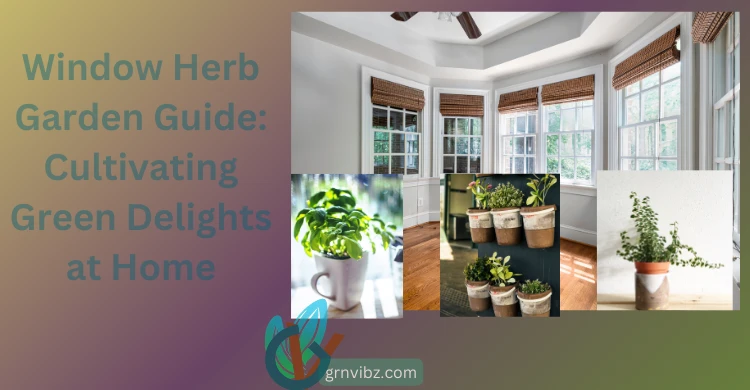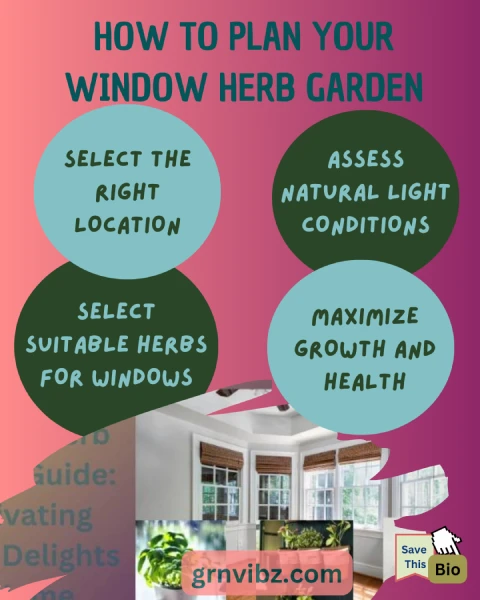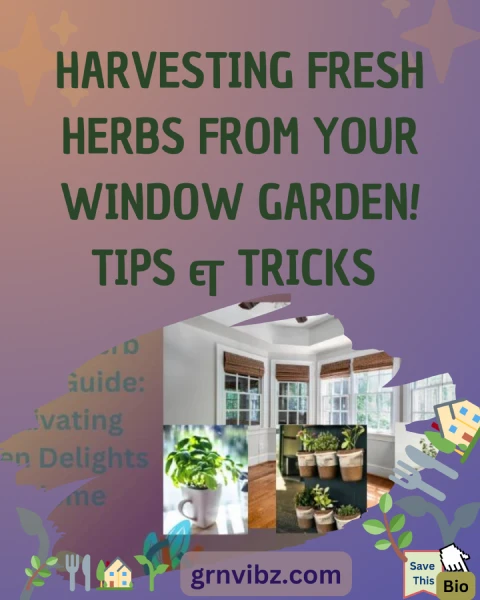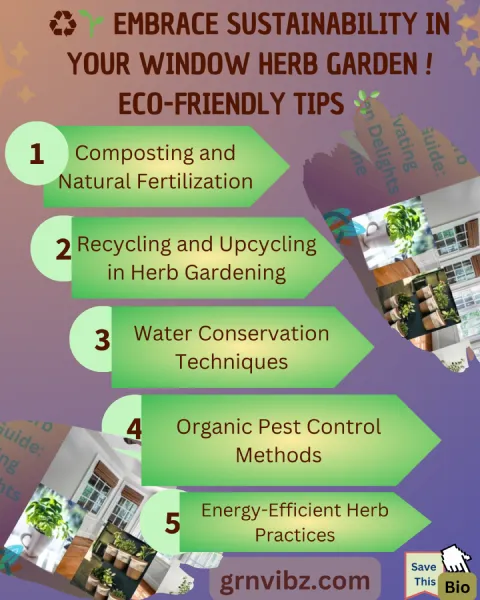Window Herb Garden Guide: Cultivating Green Delights at Home

The allure of fresh herbs has sparked an ever-growing interest in cultivating herb gardens. In today’s rapid lives, where space and time are often constrained, the concept of a window herb garden stands as a rewarding solution. if you don’t have much space for an outdoor herb garden, this comprehensive guide help you start a multifaceted realm of cultivating a windowsill herb garden right at your fingertips.
Table of Contents
Planning Your Window Herb Garden

Planning is the basic and most important step in a window herb garden for successful and thriving herbs. This step involves several essential considerations that are key to the health and growth of your windowsill herbs.
Selection of the Right Location
The location of the window plays a key role in indoor herb garden settings. Make sure that the window receives an adequate amount of sunlight. South or southwest-facing windows usually receive the most sunlight throughout the day. Take note of any barrier that may cast shadows and hinder sunlight exposure to your plants.
Assessing Natural Light Conditions
Understand the natural light patterns in your selected window. Different herbs have varying light requirements. Some thrive in direct sunlight, while others prefer partial or indirect light. Observing the light conditions at different times of the day will help you match the right herbs to the light available.
Selecting Suitable Herbs for Windows
As not all herbs thrive indoors equally, detailed information on popular herbs suitable for window gardens is crucial. Some herbs, like basil, bay, oregano, parsley, or chives, are well-suited for indoor growth due to their adaptability to limited space and indoor conditions. Consider dwarf varieties because they fit right into a window box environment. Window boxes provide the good drainage essential to most herbs.
Choose the right herbs and explore their care needs so that they thrive better in the indoor environment. For instance, herbs like rosemary and thyme prefer drier soil and a bit less sunlight compared to basil or parsley. Tailoring care based on specific herb preferences is key.
Maximizing Growth and Health
Essential nutrients, optimal temperature, natural pest management, and humidity control are major factors that impact the health and growth of your herbs. Ensure to supply proper nutrients, manage pests, and maintain suitable environmental conditions to boost your plant growth and vitality.
For instance, an application of organic fertilizers and pest control methods such as neem oil spray ensures healthy growth without harmful chemicals.
Design and Aesthetics

The design and aesthetics significantly contribute to not only the visual appeal but also the functionality of your window space. This not only helps you create innovative ideas for enhancing an environment that is both visually pleasing and practically efficient for your windowsill herbs but also encourages continuous care and interaction.
Enhancing Visual Appeal
Designing a windowsill herb garden involves incorporating elements that elevate the aesthetic appeal of your space. Use various pot designs, arrangements, and colors to add vibrancy. The addition of hanging planters, creative shelving, and tiered stands can improve the depth and visual interest in the arrangement.
Integrating Functionality
Apart from visual appeal aesthetics are crucial for functionality. Ensure to make your herb garden accessible easy to manage and convenient to snip fresh herbs for cooking or other purposes. Having a well-organized layout makes watering maintenance, and harvesting more efficient and purposeful.
Choosing Containers and Display Elements
Right containers not only impact your herb’s growth but also contribute to the overall design of your herb garden. Opt for containers that complement your interior décor and provide adequate space for the roots to grow. Get creative and innovative with container materials—ceramic, terracotta, or even recycled containers can add a unique touch to your indoor garden.
Incorporating Decorative and Functional Elements
The incorporation of practical elements within your herb garden creates a charming look. For example, decorating, organizing, or labeling your herbs enhances their looks. Additionally, adding functional elements like small garden tools or a watering can as part of the display can be both aesthetically pleasing and handy for garden maintenance.
For example, set up a vertical herb garden on a wall near a kitchen window with a mix of differently-sized pots. Finally, arrange them vertically to create a visually appealing garden that is space-efficient and easily accessible for culinary use.
Harvesting and Utilizing Your Herbs

Harvesting techniques, storage tips, and the diverse applications of freshly harvested herbs help you ensure continual growth and maximum benefits from freshly planted herbs.
Harvesting Techniques
It’s important to understand when and how to harvest herbs. This enables you to collect or harvest herbs at their peak concentration of essential oils. For instance, many herbs have the highest essential oil concentration before they flower while others have it after flowering.
Storage and Preservation Tips
Proper storage after harvesting guarantees the durability and freshness of your herbs. Herbs can be preserved in a number of ways, such as drying, freezing, or keeping them in vinegar or oil. Many herbs like rosemary or thyme can be dried, while others like basil are better preserved in oil.
COSORI Food Dehydrator
The COSORI Food Dehydrator is a powerful 600W dryer with 6 stainless steel trays, offering 6.48ft² of space for dehydrating meats, fruits, and more. it features a max temperature of 165°F, a 48-hour timer, and even air circulation for quicker, healthier treats. It comes fully equipped with accessories
Culinary and Medicinal Uses
Herbs have a wide range of applications in the kitchen and medicine. Incorporate them into different recipes to improve and add taste. Many herbs also have therapeutic qualities, and they can be used as natural treatments for minor illnesses or as teas or infusions.
Vertical Raised Garden Bed
For Herbs, Vegetables & Flowers
5-Tier 4Ft Vertical Raised Garden Bed: Grow herbs, vegetables, and flowers effortlessly in this space-saving, easy-to-assemble planter. Each 22″ container offers ample room for plants in apartments, balconies, or gardens. Made from food-grade, BPA-free plastic, it’s ideal for those with mobility issues.
Sustainability and Eco-Friendly Practices

Composting and Natural Fertilization
Composting practices for your window herb garden not only promote sustainability but also create a pool of essential nutrients at no cost. Kitchen scraps like vegetable peels or coffee grounds are sufficient to produce nutrient-rich compost. This natural fertilizer reduces waste and provides your herbs with essential nutrients.
Recycling and Upcycling in Herb Gardening
Embrace sustainable practices by recycling and upcycling materials for your herb garden. Repurpose household items like cans, bottles, or old containers as window planters. This not only reduces waste but also gives a new life to items that would otherwise be discarded, contributing to an eco-friendly environment.
Water Conservation Techniques
Maximize water efficiency by employing strategies such as collecting and reusing water. Capture rainwater or repurpose water from household activities (like rinsing vegetables) to water your herbs. Installing a simple irrigation system or self-watering window planters can reduce water usage and ensure your herbs receive adequate hydration without wastage.
Organic Pest Control Methods
Opt for eco-friendly pest control approaches to maintain a healthy herb garden. Natural remedies like neem oil, garlic spray, or companion planting techniques can deter pests without the use of harmful chemicals. By avoiding synthetic pesticides, you protect the environment and the health of your herbs.
Energy-Efficient Herb Practices
Consider the energy impact of your herb exercise. For instance, monitor light duration and use timers to ensure efficient energy use while providing the necessary light for your indoor garden. Similarly, opt for energy-efficient sources or LED lights to reduce energy consumption.
These practices help you reduce waste, conserve resources, and support a more harmonious relationship between your gardening endeavors and the world around you.
Takeaway
This comprehensive guide equips both beginners and seasoned gardeners with the knowledge to create and maintain a flourishing window herb garden. Apply this information to transform your window space into a thriving green haven. Incorporate sustainability and eco-friendly practices in your window herb garden to clean the environment and promote a healthier and more natural approach to herb cultivation.
FAQs on Window Herb Garden
1. What herbs are best for the window option?
Basil, mint, thyme, parsley, and rosemary are great choices for windowsill herb gardens due to their adaptability to indoor conditions.
2. How often should I water my window herb garden?
It depends on the herb and environmental conditions. Water when the top layer of the soil feels dry but avoid waterlogging the roots.
3. What if my herbs are not growing well?
Check for adequate sunlight, proper watering, and drainage, and consider repotting or changing the location if necessary.







